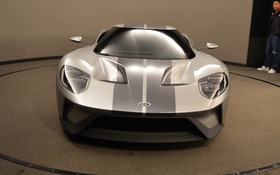2017 Ford GT: Out To Get Ferrari—Again!
Just a few days ago, Ford invited journalists to a special forum for the GT, the car that sent chills down everyone’s spine at the Detroit Motor Show. And we learned lots of cool details about it!
The first GT, the GT40, won four consecutive 24 Hours of Le Mans events, from 1966 to 1969, beating Ferrari, the brand that Henry Ford reviled. (As a reminder, in the early 1960s, Ferrari was in bad financial shape and wanted Ford to buy them out. But Enzo pulled out of negotiations at the last minute, much to the annoyance of Henry II. In an act of vengeance, the GT40 was created.) At the time, this car represented the leading-edge of technology. The second generation GT appeared in 2005 and 2006. Almost identical in look to the first gen, it too boasted the latest technologies, which included aluminum construction and ABS brakes—and that’s about it! Back then, electronic systems were just being developed and weren’t yet on offer.
For the past few years, we’ve seen major advancements in mechanical, communication and safety systems. You might even call it a technological revolution. The next GT will be chock-a-block with sensors, computers and communications tools.
More code than a Boeing 787 Dreamliner!
In their efforts to impress the press, Ford came to the event with an impressive list of fun facts. Fifty parameters are constantly checked, including outdoor temperature, vehicle speed, ABS brakes, steering wheel position, pedal position and I could go on, but it would take up too much space. Within thousandths of a second, these parameters are handled by 25 microprocessors controlled by 10 million lines of code. A Boeing Dreamliner has just 6 million. When we realized that the car had almost twice the amount of code as an aircraft, we couldn’t help remarking to an American colleague that they might have wanted to trim it down a little.
Above all else, the Ford GT was designed to be like a race car, with highway capabilities being a secondary concern. The word “track” came up a lot during the forum. Everything, absolutely everything, about this vehicle is controlled by computers. Drivers have four driving modes to choose from: Normal, Sport, Track and Wet. The engineers are still tweaking the settings, but we’re fairly sure the Sport mode will be permissive and scare the living daylights out of Sunday drivers.
I would also bet that Track mode should only be used by professional drivers. Wet mode is likely to be the same as Snow mode on more average vehicles, which means it will cause the transmission to shift sooner and make the accelerator less sensitive—while still remaining adapted for track use. These modes were developed in a simulator, the kind you see in Formula 1. This allowed Ford to fine-tune hundreds of computer system interactions, even before the first prototype was built.
All about personal taste
Esthetically, the Ford GT is very nice. Designed for optimum aerodynamics, it’s almost totally flat. This is especially pronounced at the back, where the roofline and rear window (if you can call it a window) are barely inclined at all. This creates serious—and effective—downforce. At “normal” speeds, the rear spoiler will remain down. It will only raise at high speeds to nail the car to the ground. When you brake at high speeds, the spoiler moves to an almost vertical position, creating an aerodynamic brake, like on an airplane or Bugatti Veyron.
The GT’s interior is extremely narrow if you ask me. For safety reasons, the seats are fixed. Instead, the steering column and pedals change position around you. That said, you can at least adjust the seatback. Having fixed seats also helps reduce the vehicle’s overall weight. Slide rails and adjustment mechanisms are heavy, even if they’re not powered. One of the designers assured us that even at 6’2’’, he can easily get comfortable behind the wheel, even when wearing a helmet. Although I’m skeptical, I’m keeping my mind open until I have the chance to try it myself.
The GT’s designers also made a big effort to reduce driver distractions. For example, the steering wheel has so many controls it’s practically a dashboard (much like on race cars). Even the indicators are activated by buttons on the steering wheel. To ensure good grip, none of these buttons are smooth, nor are the shifting paddles. The GT will come with Sync3, a multimedia system that Ford promises will be much more user-friendly than the current generation. We’ll have a chance to see for ourselves when some of the 2016 production models come out later this year.
Weight loss plan
To keep the GT light on its feet, Ford included plenty of carbon fibre in the interior. There’s no leather whatsoever, as it’s too heavy. When we were in Detroit, we met with the technical director of the materials department. He told us about the latest advancements in vehicle weight reduction, which include making parts out of carbon fibre, aluminum or various alloys. On a Ford Fusion concept, these tactics resulted in a net loss of 800 lbs (363 kg). The GT will capitalize on all this research.
Since we were looking at the car with a small team of engineers and designers, we learned a lot of things. Some big, some small, but nothing of substance. We still don’t know how much power the 3.5L EcoBoost V6 will deliver, though they’ve confirmed it will be more than 600 horsepower. A seven-speed dual-clutch transmission will connect the engine to the rear wheels. While the price has yet to be confirmed, a lot of people are saying it will be around the $400,000 mark. This would put it roughly on par with a Lamborghini and some Ferraris. That makes sense. No more than 250 units will be built per year worldwide.
The super sports car market is heating up and the 2017 Ford GT is ready to capitalize on the trend. Plus, it will bring a more affluent vibe to showrooms, which is invaluable for Ford. And lastly, the technical innovations introduced in the GT will make their way to other blue oval products and positively impact the public’s perception of the brand.
With spectacular looks, advanced engineering, limited production and a sky-high price, the GT is destined for success!












